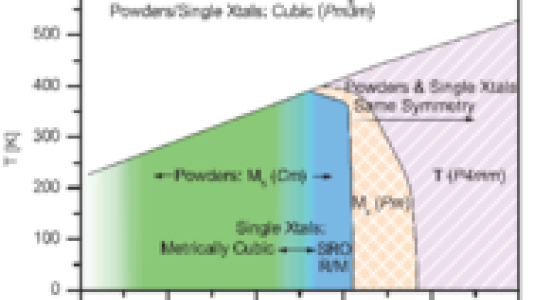
We explored the putative role of polar nanoregions (PNR) in the physics of relaxor ferroelectrics in the canonical PMN-xPT system using neutron diffraction on single- and polycrystalline specimens. Our key result was the formation of ferroelectricity (i.e. monoclinic symmetry) in the latter but not the former. We hypothesize that this reflects the importance of near-surface ‘skin effect’ more easily seen in the powders. Importantly, our work implies that in bulk materials there exists a coupling between relaxational properties and suppressed long-range order, a necessary condition for the PNR model.
Redetermined phase diagram of PMN-xPT through neutron diffraction, emphasizing differences between single- and powder samples traced to skin effect.
In close collaboration with the Neutron and X-ray Scattering program, we are exploring how random electric fields can offer insights beyond those accessible through the random field Ising model into the general problem of disorder in random systems. We selected the relaxor ferroelectric system (1-x)PbMg1/3Nb2/3O3-xPbTiO3 (PMN-xPT) to clarify how the strongly compositionally-dependent electromechanical and dielectric properties observed in the system couple to the quenched random fields. We sought to address a widespread discrepancy among groups using different probes of the PMN-xPT long-range ordered symmetry. This symmetry is directly tied to the long-range polar (ferroelectric) order and is important to understand as prelude to investigating random field phenomena, since random fields are thought to suppress long-range order and thus lead to local nano/meso-scale ordering. As a result of this work, we developed a new phase diagram (Figure) of PMN-xPT that illustrates how the symmetries of polycrystals and single crystals evolve differently with composition, emphasizing the region of the phase diagram where the dielectric properties possess strong relaxational character (x~0-30%). The key result, made by comparing neutron diffraction profiles of both forms, is that within this regime, powders exhibit a ferroelectric, monoclinic symmetry, while single crystals have non-polar long-range order. That single crystals lack polar symmetry while exhibiting relaxational properties is consistent with a coupling between relaxational dielectric properties and suppressed long-range order in the bulk. The discrepancy between bulk and polycrystals could be understood in the context of a ~mm sized strained surface layer that is ferroelectric.
This work was done in collaboration with with P. Gehring (NIST) and Z.-G. Ye (Simon Fraser Univ.). Work at Argonne was supported by the US DOE-BES Materials Science and Engineering Division.
Publication:
“Phase Diagram of the Relaxor Ferroelectric (1-x)Pb(Mg1/3Nb2/3)O3+xPbTiO3 Revisited: a Neutron Powder Diffraction Study of the Relaxor Skin Effect” Phelan, D.; Rodriguez, E. E.; Gao, J.; Bing, Y.; Ye, Z. G.; Huang, Q.; Wen, J.; Xu, G.; Stock, C.; Matsuura, M.; Gehring, P. M. Phase Transitions 2015, 88 (3), 283. http://dx.doi.org/10.1080/01411594.2014.989226